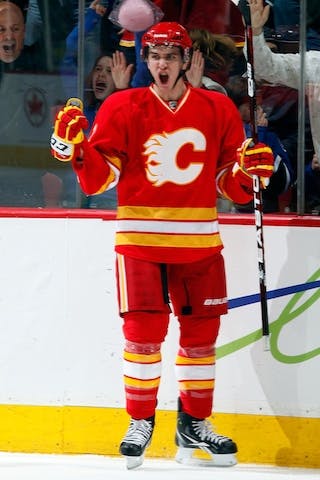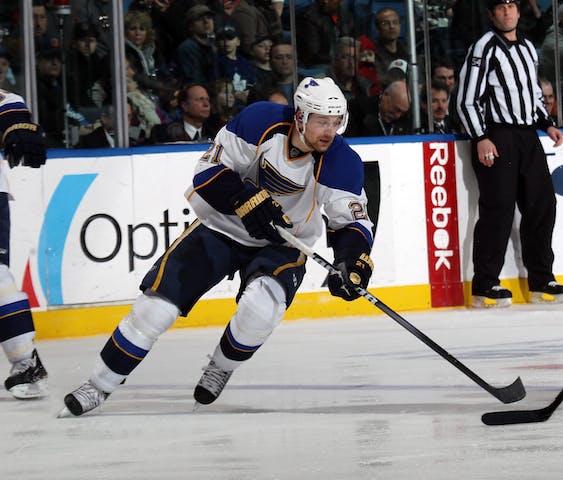Backlund, Berglund, and what progress looks like

One subject that’s never been far from the surface for Flames’ fans has been the utilization of Mikael Backlund. Calgary’s one NHL-ready youngster has spent most of the year playing 4th liners to good effect, even as a segment of the fan base advocated he be moved up the scale ahead of Stajan, Jokinen or Morrison at varying junctures of the year.
I don’t doubt that a lot of that sentiment is as a result of the shortcomings, perceived or real, of the three aforementioned gents, but there’s also been a sentiment that Backlund was ready to blossom into a proper top six forward.
I suspect last night’s dire performance against the Coyotes might have chilled that sort of talk for a few folks, but rather than rag on Backlund for a bad night when the coach had to throw him into a situation beyond his current abilities, I want to shift the focus to what might lie ahead. To do so, I’m going to briefly examine one of his fellow Swedes’ progress through his first three years in the league as a comparative.
Patrik Berglund is likely one of the cornerstones for the Blues’ ongoing rebuild. The 22 year old center is in the final year of his ELC, with RFA status awaiting him this summer. He was drafted 25th in 2006, pretty much in line with Backlund’s selection at 24 one year later. After a flashy debut in 08/09 where he finished with 21 G and 27 A in 76 games, Berglund appeared to fall back last season, managing only 13G 13A. This year, he’s having a good scoring season, tallying 18G and 27A through 69 games.

There’s always more to a player’s success than just boxcars, of course, and that’s where my focus will be. If one only looked at points, there’d be the sense that Berglund was becoming a proper top sixer. That might yet happen, but there are a number of factors at play that have driven his totals beyond his actual contribution at EV.
What really struck me as I looked at the numbers is that through two coaches and nearly three full seasons in the NHL, Patrik Berglund’s QComp and ZoneStarts relative to his teammates have remained in the same range. I set the filters at BTN for 40 games played for 08/09 + 09/10, 30 for this year, and 10 min TOI at EV:
| Rel Qcomp | RelCorsi | PDO | ZS | |
| (1st=tough) | (1st=best) | (1st=easiest) | ||
| 2008/09 | 8 of 11 | 7 of 11 | 105.4 | 59.8, 2 of 11 |
| 2009/10 | 9 of 11 | 1 of 11 | 97.9 | 59.7, 1 of 11 |
| 2010/11 | 9 of 9 | 2 of 9 | 96.9 | 61.7, 1 of 9 |
So, what do we have? Berglund rode the PDO train pretty hard his first year to finish at 42GF/20GA at EV. His outshooting numbers really didn’t justify his +/-, in other words. Andy Murray was pretty sensible in sheltering a first year player both in terms of competition and faceoff postion, even with several other relatively young players in his lineup.
Last season wasn’t as fruitful in terms of boxcars, but at least one could argue that Berglund started moving the ball forward in terms of his actual play. He again got the easy pickings, but he outplayed his opposition only to fall victim to the percentages. His numbers in his second year in terms of EV scoring are actually right in line with Backlund’s at EV. Berglund had 17 EV points in 71 games, averaging 11 EV minutes a game. Backlund has 17 EV points in 63 games, averaging just over 10 EV minutes a night with a PDO of 99.0 and a ZS number just under 57%, so, as I said, right in range.
This season’s numbers for Berglund strike me as a bit surprising. The Blues did have Jay McClement doing all the heavy lifting before his trade to Colorado, but Berglund is getting the easiest minutes possible. He’s smoking his opposition again in terms of outshooting, and his total minutes are up as well, to 13:34 a game at EV.
He has 28 EV points so far this year in 69 games, so his scoring rate has moved from 1.25 PTS/60 to 1.70/60. Still, given his progress in terms of outshooting last year, I would have thought he’d be due for a slight uptick in responsibility, and at least until the McClement trade, it wasn’t happening at all.
Now, when the subject of overall scoring comes up, Berglund has had the advantage of playing on a team that gave him worthwhile PP time, so Backlund’s boxcars won’t look as good in comparision, but his EV outshooting numbers aren’t much different than Berglund’s at the same point, and the Flames are a better team than the Blues have been the last few years, so any young player would have to expect to deal with more of a pecking order unless they were clearly elite from day one.
The gist of all this is that even a team like St. Louis, one that’s really asked younger guys to play more minutes due to financial circumstance, has been pretty careful with its top center prospect. Patrik Berglund likely won’t have the training wheels fully taken off until next year, with three full NHL seasons under his belt.
Mikael Backlund, should he follow the same sort of sensible progression, should see an uptick in his EVTOI and responsibility to consistent third line levels next year along with more PP time, and then he really should be asked for more starting in 12/13. Until that point, even though it’s easy to get caught up in the deficiences of the team right now, Brent Sutter’s careful approach this year hasn’t been out of line with what happens around the league.
Recent articles from Robert Cleave





